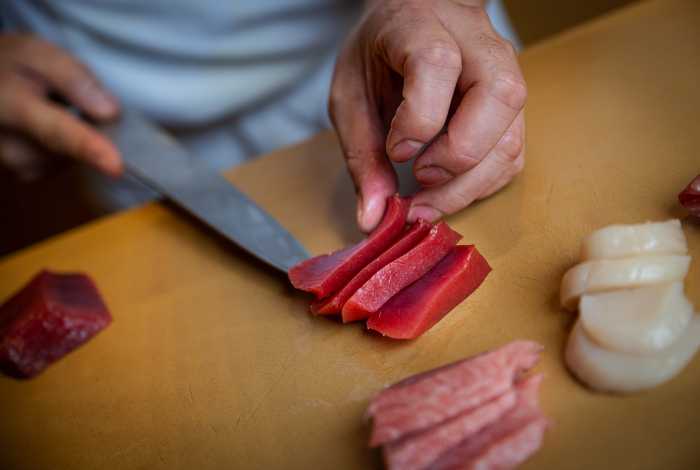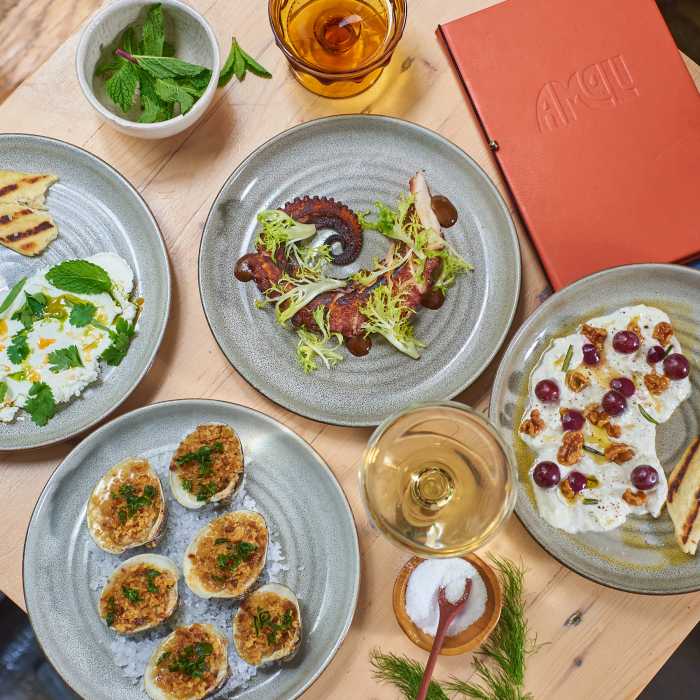For Leah Koenig, Jewish holidays are all about the “showstoppers” on the table.
“There’s everyday Jewish food, and then there’s the holidays,” she says. “That’s the time we are having these symbolic, ritual, family-centered meals. They have a lot of memory and just good feelings attached to them.”
And “Little Book of Jewish Feasts” — the second book in her Jewish food trilogy (her first, on appetizers, came out last year, and the third, on dessert, is due out next year) — is all about the showstoppers.
Like “Modern Jewish Cooking,” her first cookbook, they take a global approach.
“These books are meant to be really highly curated tastes of different aspects of Jewish cuisine,” Koenig says.
A recipe from the “Feasts” cookbook that Koenig plans to make for Rosh Hashanah this year is the vegetable tagine, a Moroccan dish that has seven different vegetables that represent the Jewish calendar’s seventh month, during which the holiday falls.
“Each of the vegetables in it has some kind of symbolic meaning,” says the Kensington resident, who’s a fan of nearby 24-hour produce markets like Three Guys from Brooklyn and Circus Fruits. “It’s pretty cool that you’re basically eating food symbols.”
Flavor-wise, the spiced dish isn’t too powerful, but has a “wonderful mix of warming spices, like cinnamon and cumin,” says Koenig, who likes to load up on spices at Kalustyan’s in Kips Bay. “It has this complex palate of flavors.”
Golden raisins add sweetness — another symbolic holiday staple — and chickpeas some hearty protein.
Koenig, who keeps kosher, also likes the tagine because it’s meat-free.
“I like to save one of the meals to be totally vegetarian, so we can really indulge and make an apple cake, or something with ice cream,” she says, adding that it’s also a plus for vegetarian guests.
Koenig recommends serving the tagine over steamed couscous.
“It’s so beautiful on the platter, when you put the couscous down and the tagine on top,” she says. “It’s really an elegant dish that’s not terribly hard to prepare.”
Seven-vegetable tagine
Serves 6 to 8
- 1⁄4 cup sliced almonds
- 1⁄4 cup extra-virgin olive oil
- 2 medium onions, halved through the root and thinly sliced
- 4 plum tomatoes (about 1 lb.), seeded and chopped
- 2 garlic cloves, finely chopped
- 1 tsp. ground cinnamon
- 1 tsp. sweet paprika
- 1 tsp. ground ginger
- 1⁄2 tsp. ground turmeric
- 1⁄2 tsp. ground cumin
- 1⁄2 tsp. ground coriander
- 1⁄2 tsp. red pepper flakes
- 1 15-oz. can chickpeas, rinsed and drained
- 2 zucchinis, halved lengthwise and sliced into 1⁄2-in. moons
- 2 cups butternut squash, peeled and finely chopped
- 2 large carrots, peeled, halved lengthwise and cut into 1⁄2-in. pieces
- 1⁄3 cup golden raisins
- 2 1⁄2 cups vegetable stock
- Kosher salt and freshly ground black pepper
- Chopped fresh flat-leaf parsley for garnish
1. Put the almonds in a large pan set over medium-low heat and toast, shaking the pan occasionally, until fragrant and lightly browned, 5-7 minutes. Remove the pan from the heat and let cool; set aside.
2. Heat the oil in a medium saucepan set over medium-high heat. Add the onions and cook, stirring occasionally, until softened and lightly browned, 7-10 minutes. Add the tomatoes and cook, stirring occasionally, until softened, 3-5 minutes. Add the garlic, cinnamon, paprika, ginger, turmeric, cumin, coriander, and red pepper flakes and cook, stirring, until fragrant, 1-2 minutes.
3. Add the chickpeas, zucchini, butternut squash, carrots, raisins, stock, 1 tsp. salt, and a generous amount of pepper and bring the mixture to a simmer. Turn the heat to low, cover the pot and cook until the squash and carrots are tender, about 20 minutes. Uncover and continue cooking, stirring occasionally, until the sauce thickens slightly, about 10 minutes. It will still be somewhat liquidy, but should more closely resemble a stew than a soup. Taste and add more salt, if desired. Serve hot, sprinkled with parsley and almonds. Store leftovers, covered, in the fridge for up to 5 days.
Reprinted from “Little Book of Jewish Feasts” by Leah Koenig with permission by Chronicle Books, 2018.
Read More: NY Presidential Primary: Vote Tuesday Despite Biden & Trump






































